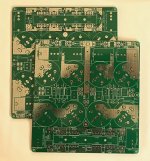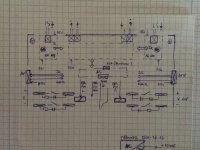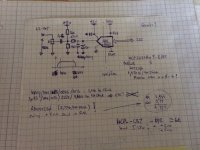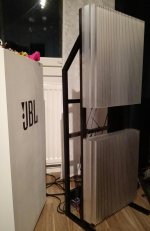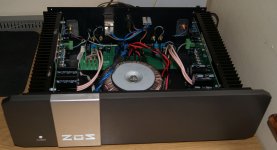B.B. power supply options...
As I am currently running the 20W Alpha from a P2P F6 PSU with good results, I am wondering if I should build up these really sweet looking JPS64 Specials: F6 PSU PCBs with all the usual JP fixin’s
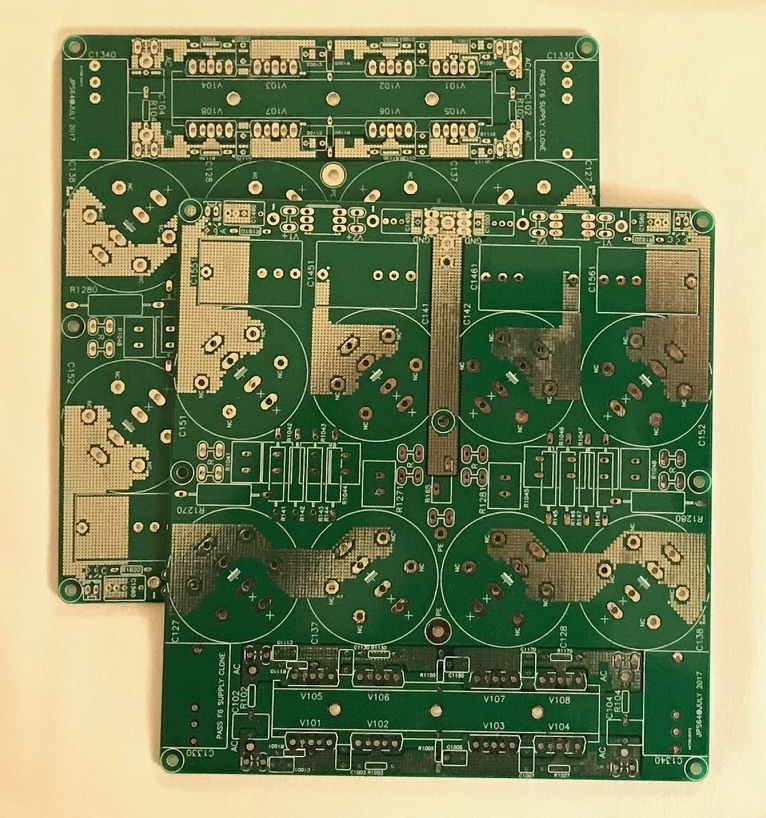
BOM here:
http://www.diyaudio.com/forums/attachments/group-buys/671731d1522310061-gb-jps64_f6_psu-zip
I could splurge and get 8 x 33mF caps per board or is 8 x 15mF enough? They were designed for a stereo 1.2amp per channel F6. The B.B. is about 3amps per channel so maybe 8 x 22mF might be more appropriate. But these are designed to be stereo PSU’s with dual sets of RC’s on the output. Will have to think about it. I might just use my Prasi/Project16 CRCs to start off the Beta test and save these for the final boxed build.
CDE 33mF 35v (manufacturer number 339LBB035M2EH) are $5.50ea. Hmm...
As I am currently running the 20W Alpha from a P2P F6 PSU with good results, I am wondering if I should build up these really sweet looking JPS64 Specials: F6 PSU PCBs with all the usual JP fixin’s
BOM here:
http://www.diyaudio.com/forums/attachments/group-buys/671731d1522310061-gb-jps64_f6_psu-zip
I could splurge and get 8 x 33mF caps per board or is 8 x 15mF enough? They were designed for a stereo 1.2amp per channel F6. The B.B. is about 3amps per channel so maybe 8 x 22mF might be more appropriate. But these are designed to be stereo PSU’s with dual sets of RC’s on the output. Will have to think about it. I might just use my Prasi/Project16 CRCs to start off the Beta test and save these for the final boxed build.
CDE 33mF 35v (manufacturer number 339LBB035M2EH) are $5.50ea. Hmm...
Attachments
Last edited:
X,
I believe, based on your listening sessions and those of Vunce and PCgab (?), I hope that this circuit will rank with Pass' other DIY amps in time. If I were him, or even JLH, I would be very, very proud that their designs have lasted so many years. I was around the year the JLH 10W amp was released in 1969 and my experience lasts to this day (as many in my University days..... but that is another story!). The JLH is still around, at that time Nelson Pass was my age - 18 years - and had not yet left his indelible mark on the industry.
When you consider the Class D amps which had begun to dominate midfi and particularly the auto audio about ten years, it is actually remarkable that the best, the most engaging and the most musical amps are still the Class A linear circuits.
Here's hoping the ALPHA comes to rank with its forefathers, particularly the JLH and the Aleph from which its heritage is derived......
Hugh
Hi Hugh,
Thanks to your ability to generate neat new topologies - we may indeed have in our hands, a young baby amp that will grow up to be an enduring classic. Only time will tell, but in the meantime we all get to listen to an incredible amp. The 52w B.B. might be an over the top “Class A Nutter” amp, but what we are laying out here is a plan that allows mere mortals to atempt it. No massive expensive heatsinks needed, no matching of outputs needed, no unobtanium parts needed, no adjustments needed. I look forward to building it up this weekend. A 200 damping factor in a SE Class A amp capable of 52w is kind of unusual isn’t it? We will see how it works and sounds soon.
Thanks again Hugh, and my sincere thanks to JP for his amazing professional layouts that are just eye candy beautiful and contain all the tricks of the trade with respect to layout and grounding best practices. Engineering as Art.
Live Long and prosper, Amp ALPHA!
Last edited:
I couldn’t agree with you more Hugh. I went down the class D road. I used amp modules from several of the usual manufacturers. Yes, they definitely have some advantages but, for best sound quality in my opinion they fell short.
As X has said, the ALPHA20 is a very easy, super sounding class ’A’ amplifier to live with. Hopefully, the BB version will give diy’ers even with inefficient speakers the opportunity to successfully live with and enjoy an ALPHA for many years
As X has said, the ALPHA20 is a very easy, super sounding class ’A’ amplifier to live with. Hopefully, the BB version will give diy’ers even with inefficient speakers the opportunity to successfully live with and enjoy an ALPHA for many years
JPS64,
If you have any more updates on what your plans for the microController VU/Safety/Fan/FFT/Temps/R2R-volume controller is, that would be great. Btw, the R2R volume controller was my idea just to throw it all in there. Now all we need is an app on our phone that manages the B.B. amp!
If you have any more updates on what your plans for the microController VU/Safety/Fan/FFT/Temps/R2R-volume controller is, that would be great. Btw, the R2R volume controller was my idea just to throw it all in there. Now all we need is an app on our phone that manages the B.B. amp!
ALLO - Relay Attenuator * Volumio
Complete music system with dac and BB, I don't doubt the Pi can be used for VU and controll too
Complete music system with dac and BB, I don't doubt the Pi can be used for VU and controll too
B.B. power supply options...
As I am currently running the 20W Alpha from a P2P F6 PSU with good results, I am wondering if I should build up these really sweet looking JPS64 Specials: F6 PSU PCBs with all the usual JP fixin’s
[/QUOTE
Hi X,
What rectifiers and heatsink would you use with these psu’s?
What rectifiers and heatsink would you use with these psu’s?
It looks like it is designed for large TO247 rectifiers and maybe TO220 MUR's could fit (these are all rather pricey and heat sink may be limited). I will probably just use external square pucks and connect at appropriate input point. But the rest of the PCB has some nice features.
After busy week, still working on ALPHA BB controller board:
- HCPL-C87x voltage sense or 10/12bit ADC + ADUM1250 (I2C)
- R2R relays attenuator (front encoder + IR receiver)
- I2C fan boards interface
- epaper 3 colours display (>= 4.2 inches)
- main power switch and R/L secondary power amplifier DC switch
- DC blocking electronic
- CL60 inrush current limiter
Arduino board or Atmel microcontroller solution not fixed yet.
I hope fixing and finishing prototype during Eastern.
JP
- HCPL-C87x voltage sense or 10/12bit ADC + ADUM1250 (I2C)
- R2R relays attenuator (front encoder + IR receiver)
- I2C fan boards interface
- epaper 3 colours display (>= 4.2 inches)
- main power switch and R/L secondary power amplifier DC switch
- DC blocking electronic
- CL60 inrush current limiter
Arduino board or Atmel microcontroller solution not fixed yet.
I hope fixing and finishing prototype during Eastern.
JP
Attachments
Can you comment a about it please?DC blocking electronic
In my mains I have a lot of DC and it took me time to eliminate it in my audio equipment.
Had to try Alpha with passive cooling..I know X like skeleton cases too  old frame and stuffed Alpha gear in, took about 3 hours of drilling, tapping and working couple of wires. CapMX is in lower section, and it really warms up comparing to upper section that contains only one channel of Alpha. Sorry about bad picture, listening it atm, speaker- and signal wires aren't attached very well. Prototyping is ready now, next I have to give new looks for the frame and that's always the hard part..paint in the frame didn't like heat and it's mostly burned, have to remove it somehow before working further.
old frame and stuffed Alpha gear in, took about 3 hours of drilling, tapping and working couple of wires. CapMX is in lower section, and it really warms up comparing to upper section that contains only one channel of Alpha. Sorry about bad picture, listening it atm, speaker- and signal wires aren't attached very well. Prototyping is ready now, next I have to give new looks for the frame and that's always the hard part..paint in the frame didn't like heat and it's mostly burned, have to remove it somehow before working further.
Attachments
Last edited:
Here is a protection and power control I did for commercial amp ZUS in 2013.
Maybe it is a good kick-off point or someone might just want to make it as is. There are PDF plots so you can see what it looks like and PIC micro source code and Gerber plots included. Sorry I use EasyPC 10.
Maybe it is a good kick-off point or someone might just want to make it as is. There are PDF plots so you can see what it looks like and PIC micro source code and Gerber plots included. Sorry I use EasyPC 10.
Attachments
Had to try Alpha with passive cooling..I know X like skeleton cases tooold frame and stuffed Alpha gear in, took about 3 hours of drilling, tapping and working couple of wires. CapMX is in lower section, and it really warms up comparing to upper section that contains only one channel of Alpha. Sorry about bad picture, listening it atm, speaker- and signal wires aren't attached very well. Prototyping is ready now, next I have to give new looks for the frame and that's always the hard part..paint in the frame didn't like heat and it's mostly burned, have to remove it somehow before working further.
The capmx gets hotter than ALPHA, mmmmm, something oscillating ?
The capmx gets hotter than ALPHA, mmmmm, something oscillating ?
I have no idea, never had any build oscillating before? I'm running original, bigger bias.
Just to be clear, lower sink gets warm after 2 hours, upper a little less. Nothing compared to previous 60w Aleph that use to populate these heatsinks, those were hot, these are warm
Edit: and paint burned when there were Aleph 5 dualmono inside.
I have no idea, never had any build oscillating before? I'm running original, bigger bias.
Just to be clear, lower sink gets warm after 2 hours, upper a little less. Nothing compared to previous 60w Aleph that use to populate these heatsinks, those were hot, these are warm
Edit: and paint burned when there were Aleph 5 dualmono inside.
It is hard to tell if/when a single ended amp oscillates just by the temp simply because it is already hot. I would say thermal runaway or bias is shifting is more likely.
It is hard to tell if/when a single ended amp oscillates just by the temp simply because it is already hot. I would say thermal runaway or bias is shifting is more likely.
Is there a way to tell for sure, without owning an oscillator? Don't really even know anything about oscillation, haven't even thought of that since this is so easy, nice and simple build
1.9amp x 4v x 4 devices = 30w. Should be about 1/3rd heat dissipation of the actual amp at 1.9amp x 48v =90w.
Hmm, I have 12 x 22 000uF capacitors and readily built CRC filter with them, maybe I try this without capMX when inspired next time.
- Home
- Amplifiers
- Solid State
- Aksa Lender P-MOS Hybrid Aleph (ALPHA) Amplifier
